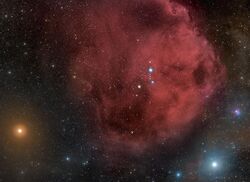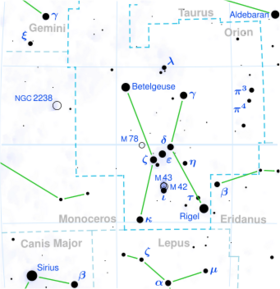Astronomy:Phi1 Orionis
| Observation data Equinox J2000.0]] (ICRS) | |
|---|---|
| Constellation | Orion |
| Right ascension | 05h 34m 49.23804s[1] |
| Declination | +09° 29′ 22.4878″[1] |
| Apparent magnitude (V) | 4.42[2] |
| Characteristics | |
| Spectral type | B0 III[3] |
| U−B color index | −0.97[2] |
| B−V color index | −0.15[2] |
| Astrometry | |
| Radial velocity (Rv) | +33.2[4] km/s |
| Proper motion (μ) | RA: +0.27[1] mas/yr Dec.: −2.26[1] mas/yr |
| Parallax (π) | 3.00 ± 0.25[1] mas |
| Distance | 1,090 ± 90 ly (330 ± 30 pc) |
| Absolute magnitude (MV) | −3.53±0.30 |
| Orbit[5] | |
| Period (P) | 3,068.03 d |
| Eccentricity (e) | 0.22 |
| Periastron epoch (T) | 2418051.8 JD |
| Argument of periastron (ω) (secondary) | 105° |
| Semi-amplitude (K1) (primary) | 13.3 km/s |
| Details[6] | |
| Mass | 15.5±1.1 M☉ |
| Radius | 6.3±1.0 R☉ |
| Luminosity | 28,840 L☉ |
| Surface gravity (log g) | 4.05±0.10 cgs |
| Temperature | 30,000±300 K |
| Rotational velocity (v sin i) | 20[7] km/s |
| Age | 7.2±0.8[8] Myr |
| Other designations | |
| Database references | |
| SIMBAD | data |

Phi1 Orionis is a binary star system in the constellation Orion, positioned less than a degree to the south of Meissa.[10] It is visible to the naked eye with an apparent visual magnitude of 4.42.[2] The distance to this system, based upon an annual parallax shift of 3.0 mas,[1] is around 1,090 light-years.
This is a single-lined[6] spectroscopic binary star system with an orbital period of 3,068 days and an eccentricity of 0.22.[5] It is a member of the young Lambda Orionis cluster[11] and is roughly 7 million years old.[8] The primary component is a B-type giant star with a stellar classification of B0 III.[3] It has over 15 times the mass of the Sun and around 6.3 times the Sun's radius.[6] Nothing is known about the secondary companion. It does not contribute a significant amount of light to the combined spectrum.[6]
References
- ↑ 1.0 1.1 1.2 1.3 1.4 1.5 van Leeuwen, F. (2007), "Validation of the new Hipparcos reduction", Astronomy and Astrophysics 474 (2): 653–664, doi:10.1051/0004-6361:20078357, Bibcode: 2007A&A...474..653V.
- ↑ 2.0 2.1 2.2 2.3 Murdin, P.; Penston, M. V. (December 1977), "The Lambda Orionis association", Monthly Notices of the Royal Astronomical Society 181 (4): 657–665, doi:10.1093/mnras/181.4.657, Bibcode: 1977MNRAS.181..657M.
- ↑ 3.0 3.1 Levato, H. (January 1975), "Rotational velocities and spectral types for a sample of binary systems", Astronomy and Astrophysics Supplement Series 19: 91–99, Bibcode: 1975A&AS...19...91L.
- ↑ Wilson, R. E. (1953), "General Catalogue of Stellar Radial Velocities", Carnegie Institute Washington D.C. Publication (Carnegie Institute of Washington, D.C.), Bibcode: 1953GCRV..C......0W.
- ↑ 5.0 5.1 Pourbaix, D. et al. (2004), "SB9: The ninth catalogue of spectroscopic binary orbits", Astronomy & Astrophysics 424 (2): 727–732, doi:10.1051/0004-6361:20041213, Bibcode: 2004A&A...424..727P.
- ↑ 6.0 6.1 6.2 6.3 Nieva, María-Fernanda; Przybilla, Norbert (2014), "Fundamental properties of nearby single early B-type stars", Astronomy & Astrophysics 566: A7, doi:10.1051/0004-6361/201423373, Bibcode: 2014A&A...566A...7N.
- ↑ Simón-Díaz, S.; Herrero, A. (2014), "The IACOB project. I. Rotational velocities in northern Galactic O- and early B-type stars revisited. The impact of other sources of line-broadening", Astronomy & Astrophysics 562: A135, doi:10.1051/0004-6361/201322758, Bibcode: 2014A&A...562A.135S.
- ↑ 8.0 8.1 Tetzlaff, N. et al. (2011), "A catalogue of young runaway Hipparcos stars within 3 kpc from the Sun", Monthly Notices of the Royal Astronomical Society 410 (1): 190–200, doi:10.1111/j.1365-2966.2010.17434.x, Bibcode: 2011MNRAS.410..190T.
- ↑ "phi01 Ori". SIMBAD. Centre de données astronomiques de Strasbourg. http://simbad.u-strasbg.fr/simbad/sim-basic?Ident=phi01+Ori.
- ↑ O'Meara, Stephen James (2007), Deep-Sky Companions: Hidden Treasures, Cambridge University Press, p. 146, ISBN 978-1139463737, https://books.google.com/books?id=a6VY0Q1zsJoC&pg=PA146.
- ↑ "Spitzer Observations of the λ Orionis Cluster. I. The Frequency of Young Debris Disks at 5 Myr", The Astrophysical Journal 707 (1): 705–715, December 2009, doi:10.1088/0004-637X/707/1/705, Bibcode: 2009ApJ...707..705H.
External links
- Kaler, James B. (February 10, 2012), "Phi-1 Orionis", Stars (University of Illinois), http://stars.astro.illinois.edu/sow/phi1ori.html, retrieved 2016-11-30.
 |


